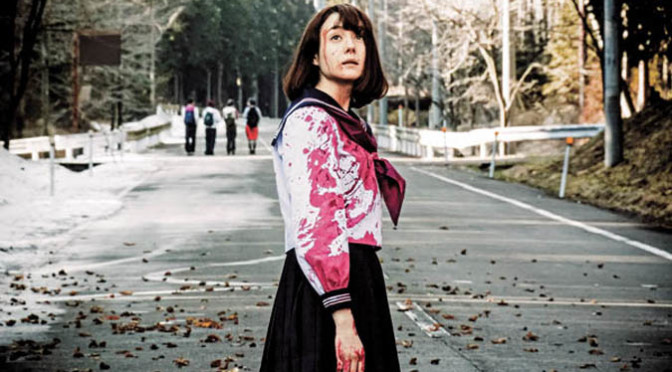Article by: Luca Richiardi Translation by: Cristiana Caffiero
Life is surreal.
There are movies with no soul which just try to step towards any directions without a reason. There are movies that are just empty and dreary. Well, this movie is just their opposite. “Tag” is directed by Sion Sono: it violently breaks in and manages to find a sharp conclusion both in a literal and figurative way. It confuses the feelings and perception of its audience but it doesn’t hide the fact that it has lost the sense of perception itself. This film needs to show its total dismay in order to penetrate the subconscious side of its audience and finally break through its conscious one. However, “Tag” is not addressed to an ordinary audience, for the simple reason that the movie is directed by Sion Sono. It’s a typical Japanese film with its peculiar artistic language which could by perceived as unfamiliar by a western audience, or at least by an audience not acquainted with Japanese pop culture.
This kind of audience might fail to notice the potential for social criticism hidden behind an excess of grotesque violence, which may appear then as empty divertissement: what has been defined, in jargon (particularly in the world of anime, manga and videogames enthusiasts) sa fanservice.
What exactly is fanservice? Excessive and pointless violence, schoolgirls in extra short miniskirts which are constantly lifted, eroticism, promiscuity, reification of the woman.
“Tag” contains all these elements. It’s thrown onto the screen in a shameless, exaggerated, intentionally provocative way, as if to ask: “Is this what you want?” As the film unravels, laughing at all this becomes a gesture that makes the spectator feel guilty.
This collage made of absurdities, which people may have fun in, is a heaven for “nerd” teenagers and hides a cruel and dreadful hell. It reveals itself step by step, while we follow the young female protagonist Mitsuko in her absurd suffering.
Among all this violence, torture and death, her loss of identity is what mostly harms. It makes her appear to be an empty box or a mannequin identical to many others. She looks as a figure, whose not uniform nature may be compared to that of Jesus and therefore doomed to sacrifice. It is a kind of essential sacrifice, a spontaneous gesture which gets away from this torture pattern felt as a function of a sadistic pleasure. And it takes place exactly in front of a parody which blames and despises these masses of obsessive fans.
What is such a heroic sacrifice aimed at? It is understood, its aim matches the film’s one: a sabotage internal to the system so that it can penetrate deeper and, hopefully, it can be able to reach and consequently wake up consciences, in order to take them away from this grotesque circle of hell.


